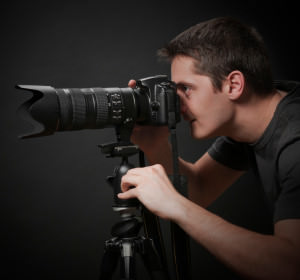 Many corporations and businesses have various needs for portrait photographs of their executives, sales team, and even support staff. These include annual reports, press releases, company newsletters, Web site, etc. If you’re already providing general portrait photography services or specialized portrait work, such as high school senior portraits, then corporate portrait projects can be a nice addition to your revenue stream.
Many corporations and businesses have various needs for portrait photographs of their executives, sales team, and even support staff. These include annual reports, press releases, company newsletters, Web site, etc. If you’re already providing general portrait photography services or specialized portrait work, such as high school senior portraits, then corporate portrait projects can be a nice addition to your revenue stream.
For the purpose of this PhotographyTalk article, it’s assumed that your corporate client requests that you shoot the portraits at the client’s location, instead of the subjects coming to your studio.
1. Before finalizing the contract, spend time at the corporation’s offices surveying the space for the best shooting location. If you have some latitude about where you can shoot, then it may be easier to use a location without windows, such as a hallway that opens into a wide space or even an employee’s break room or similar, larger room. For a group portrait, there may be no space large enough, even in a room with windows. In this case, you may have to recommend and stipulate in the contract that a group of a certain size will have to be photographed outdoors or in a studio setting.
If your client asks you to photograph executive staff members, for example, at their desks or in a room with windows, such as a board room, then that may dictate a slightly different lighting set-up than a windowless room.
2. If possible, ask your perspective client to introduce you to the employees to be photographed, so you aware of any special equipment or other considerations that may affect your contract details and fee. If it’s not possible to meet them prior to signing the contract, then make sure you do it prior to the scheduled portrait day.
3. Another important point to negotiate in the contract is the shooting schedule. It’s best to plan corporate portrait photography early in the morning when the subjects and their clothing are fresh. Make-up and hair is apt to be at their best. By the end of the day, your subjects may have trouble looking energetic. If you can convince your client to schedule the portraits a half hour or hour before the office opens, then there will be fewer possibilities for interruptions from phone calls and the other employees, as the business day commences.
4. If your client prefers the portraits in offices with windows, then you have the opportunity to shoot them in either ambient or artificial light, depending on the illumination level and direction. This is another reason why it is so important to know exactly where you will shoot and investigate that space during the scheduled time period, so you can measure how much light is coming through the windows.
5. You should only consider ambient light if the window light is strong. Corporate portraits must be clear, sharp and not artistically created with deep shadows. If possible, during your advanced meeting with your subjects, place them in the best position in their office for ambient light, and even take a meter reading. You wouldn’t want your camera to boost the ISO, resulting in visible digital noise, which your client is likely to consider unacceptable.
As with all interior, ambient light portraits, the subject should be positioned, so the light from the window is striking him or her from the side or front. Another reason to check the office prior to the shoot and at the same time is so you know in advance if the sun will strike the subject directly. Otherwise, your corporate portraits will create too many strong shadows. If you’re lucky, then there will so much ambient light that you can shoot on an overcast day, which will make the light very even, with less contrast.
6. If the light level in the room requires the use of artificial light, then you have a number of options: a single flash unit on the camera and the use of a softbox may be all you need. Again, your advanced analysis of the room will determine the correct configuration of lighting equipment.
7. Another option is to erect a portable studio, with a backdrop and a combination of two or three studio lights and a flash on the camera.
Also Read: 8 TIPS MOST PROFESSIONALS WISH THEY HAD LEARNED EARLIER
Recommended Reading:
- 2013 Photographer's Market: The Most Trusted Guide to Selling Your Photography
- How to Create Stunning Digital Photography
- Best Business Practices for Photographers
- The Fast Track Photographer Business Plan: Build a Successful Photography Venture from the Ground Up
- Group Portrait Photography Handbook
- 500 Poses for Photographing Women
- The Best of Family Portrait Photography: Professional Techniques and Images
- 500 Poses for Photographing Group Portraits
- Selling Your Photography: How to Make Money in New and Traditional Markets
- Starting Your Career as a Freelance Photographer
- Photographer's Survival Manual: A Legal Guide for Artists in the Digital Age
- Legal Handbook for Photographers: The Rights and Liabilities of Making Images
- Taking Stock: Make money in microstock creating photos that sell
- Going Pro: How to Make the Leap from Aspiring to Professional Photographer
People who read this PhotographyTalk.com article also liked:
Your feedback is important to thousands of PhotographyTalk.com fans and us. If this article is helpful, then please click the Like and Re-Tweet buttons at the top left of this article.
